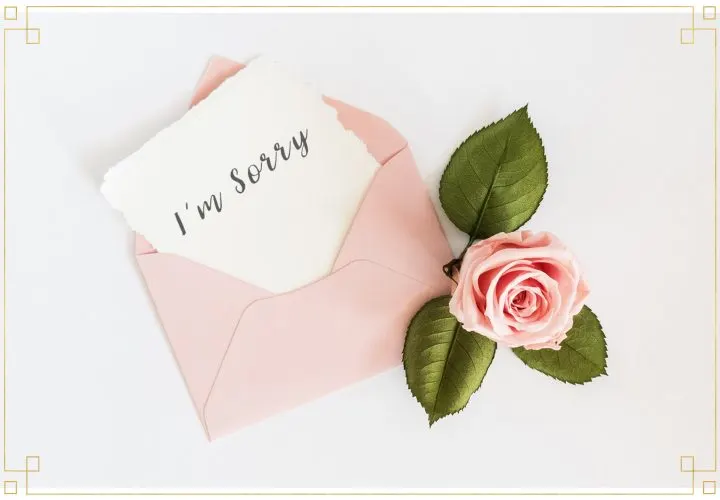April 12, 2019
How to Apologize: 14 Tips For a Genuine Apology
If you’ve ever hurt someone deeply, you’ve probably experienced the difficulty of creating a worthy apology. In an effort to convey your regret, you may have tried writing an apology letter. Though you were truly sorry, every word and phrase sounded cliche and fake. It’s important to know how to apologize because it’s a skill that you’ll use in your personal and professional life.
Apologizing lets the victim know that you aren’t proud of what you’ve done, whether it was intentional or not. It shows that you are sincerely remorseful for what happened, and you’ll do everything in your power to keep it from happening again. Much like how the truth can set you free, apologies relieve stress and save face.
That’s why we’ve generated 14 tips to help you apologize the right way. It’s not easy, but you can’t go wrong with this advice. Additionally, offering some “I’m sorry” flowers with your apology isn’t a bad idea.
1. Know When to Apologize
It’s never too late to genuinely say sorry. If you caused someone pain at any point, even unintentionally, you should offer an honest apology. If you didn’t intend to cause harm you should still apologize, but you don’t have to accept complete responsibility. Just be sure to acknowledge that you know not to do that in the future. Do not apologize if you don’t truly regret your actions. A faux apology (even if passed as a real apology) only leads to empty promises and further conflict.
2. Find a Good Time
Recognize that a good time for you to apologize may not be a good time for the other person to receive it. Don’t interrupt them if they’re busy or in a hurry to leave. When you apologize, you want to make sure that you each have the other’s undivided attention. You may even want to ask them to set aside a time to talk with you.
3. Apologize in Person
Just like a bully can hide behind a screen, so can you. People that apologize through text or email are copping out. In other words, they’re evading the real apology and raw emotions that may accompany it. For something as specific and intimate as a sincere apology, a detached medium is the last thing you want to use to communicate. Speak with them in person. As mentioned before, you can even schedule a time to do this.
4. Choose a Private Location
Once you decide to apologize, make sure that only the people involved are present. Find a separate area or room where you’ll have privacy if needed. When discussing serious matters, it’s important that both parties feel comfortable enough to open up and express their feelings. If someone doesn’t feel welcome to offer their honest opinions, your discussion won’t get very far.
5. Allow Enough Time
Don’t forget to account for how long the conversation will take. Pulling someone aside at a dinner or event to apologize is never a good idea. It’s highly likely that your apology may bring up things from the past that were brushed aside or buried. Furthermore, you should talk about what you will do to remedy the situation. This won’t be a quick five-minute discussion.
6. Use the Right Language
It’s natural for you to want to justify your decisions with “but” or to make an excuse for your behavior. However, this is immature and only causes more strife rather than offering resolution. Instead, use “I” statements to prove that you’re accepting responsibility. Speaking with positive language legitimizes your apology instead of pushing fault onto someone or something else.
7. Explain What You Did Wrong
Just like you were told as a child, you should explain what you did wrong. Your explanation shows that you understand exactly what you did to inflict pain. This is an important aspect of an apology because it means that you’re less likely to repeat the hurtful action, at least unintentionally. If you are really unsure of the problem, ask for clarification so that you can avoid it in the future.
8. Acknowledge How it Affected Them
For your apology to feel earnest, empathize with the one who is upset. By being empathetic, you’re identifying with their feelings, thoughts and attitudes. This is necessary for an apology because you’ll realize how they were affected by your choices. It may even be appropriate to offer to cover any financial damages they have suffered.
9. Express Your Regret
Conveying your regret is arguably the most important aspect of a genuine apology. Nothing else in the apology matters if you don’t have any concern for others’ feelings as a result of your actions. Part of their healing process is knowing you feel sorrowful for what you did. It helps them to know that you not only feel bad for what happened but that you care about their feelings and won’t do it again.
10. Take Responsibility
Throughout primary school, we learn how to take responsibility for our actions. Being accountable for minor mishaps such as name-calling and mess-making prepares us for how to act like adults when we’re at fault. We’ve learned, hopefully, to calmly admit guilt and apologize. A mature apology implements “I” statements as mentioned above. After you apologize, honor the other’s feelings and accept the repercussions without complaint.
11. Tell Them Your Plan To Remedy the Situation
Whether the situation requires one action or several steps to remedy, you should have a detailed plan. Develop your plan beforehand and explain it during your apology. This is the only way to ensure that you don’t make the same mistake in the future. Having ideas to resolve the problem also reinforces your remorse, helping their healing process.
12. Listen, Listen, Listen
The Greek philosopher Epictetus said that we have two ears and one mouth so we should listen twice as much as we speak. Not only should you listen when you apologize, you should actively listen. The five components of active listening are: pay attention, show you’re paying attention, reiterate the speaker’s points, don’t interrupt and respond respectfully. When you employ active listening skills, the other person will feel that you are taking their words to heart.
13. Express Gratitude
Apologizing is difficult, but gracefully receiving an apology can also be challenging. Let them know that you appreciate their time, patience and understanding. Making eye contact will portray the meaning behind your words. A simple expression of gratitude can go a long way.
14. Give Them Time
They may not accept your apology right away — and that’s okay. Don’t get upset or hurt. Even the best-crafted apologies paired with a beautiful bouquet can’t instantly mend deep rifts. After you apologize, give them as much space as they need to recover and forgive you. After all, nothing heals like time.
Apologizing can be awkward and uncomfortable for both the giver and receiver, but there’s no excuse to prolong or neglect an apology. It’s essential for moving a relationship past a dispute or misunderstanding. Expressing a genuine apology also sets a good example for your younger siblings and children (and maybe even other adults). It’s impossible to avoid all of the mistakes and conflicts you’ll encounter in your life, but knowing how to apologize properly will help you and those you affected get back on track.
If you choose to write an apology letter, you can still include the majority of these 14 golden nuggets of wisdom. Written apologies are more complicated because it’s harder to understand tone. Make sure to stress your regret without overemphasizing — as it can be interpreted as sarcasm.
Hopefully, you won’t have to apologize very often, but now you’ll know how to do it the right way.
Sources






